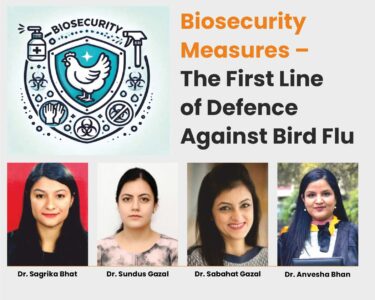
Ms. Meghana Mukherjee Salvi
Author’s Bio
Ms. Meghana Mukherjee Salvi is a poet, writer and blogger. She likes to study the market, analyse the trends and talk about everything related to Economics. Bumping into a good book is her guilty pleasure. She is a bibliophile from Bombay living with her husband and exceptional in-laws.
She followed in her father’s footsteps to set foot in the pharmaceutical industry. Before being in the poultry industry, Meghana completed her graduation in Mathematics, followed by a master’s degree in Economics.

Today, in multiple industries, digital technologies are increasingly utilised for branding, streamlining business operations and creating awareness. The veterinary industry is not far behind in embracing the digital transformation because going digital bolsters effective farm management and supply chain optimisation, which holds significance in the poultry sector. Nowadays, with the help of data, veterinarians and industry stakeholders can identify trends or patterns to arrive at informed decision-making for improved poultry welfare and productivity.
Companies and industries must transform digitally to remain relevant in today’s data-driven world. Embracing digital transformation can benefit the veterinary poultry industry by streamlining operations, enhancing animal welfare and augmenting overall profitability with better ROI in the long run. Yet, the scope of digital transformation has to be entirely realised. Thus let’s discover the various digital initiatives prevailing in the ecosystem of the poultry industry. And also shed light upon the novel avenues in the industry that can benefit from implementing future digital technologies.
The 5 technologies that can revamp the face of the Poultry industry are:
Artificial Intelligence(AI) in Poultry
AI is the buzzword of the year 2023. In times when disruption is the key to be relevant, industries globally are swooning over the next big thing: Artificial Intelligence and its applications. AI is emerging as a practical tool in automating routined task with utmost precision. In a sector like that of poultry, embroiled in challenges to production and supply, price volatility, farm bio-security, flock management and lack of skilled labour, AI can be a blessing in disguise.

The power of AI lies in data management. Often in our industry, data is collected manually and processed in computers often leads to mishandling of data and input errors, thereby affecting inference and strategy building. But, AI permits to auto collect huge chunks of data in real-time efficiently promoting accurate and detailed analysis improving overall farm productivity and enhance farm monitoring.
AI Applications
Farm management – Big Data analysis plays a primary role in establishing effective farm monitoring and management. Since the industry generates heavy data, it can be stored in cloud and remotely accessed by AI to indicate tools/machines and adjust parameters like light, temperature, ammonia levels, humidity, chick weight, water intake etc. Analysing the data equips farm owners to indulge in informed decision-making.
Disease Detection – Diseases pose massive challenge to the overall profitability in the poultry sector. AI aids in early disease detection by carefully monitoring the data. With an accurate data-set, AI can identify diseases in the incubation stage. Also, by utilising thermal imaging cameras, early detection of heat stress in flock is plausible. From bird feeding behaviour to tracking their movement, AI makes life of a farm owner/ veterinarian easier.
Embryo Detection – Non-viable eggs take up space and can be a biological hazard. However, manual detection of embryos within eggs is difficult for humans. With a heartbeat-sensor, automating the process is possible with AI.
Artificial Vision – In a poultry processing plant, AI facilitates higher processing speed, optimum packaging, and real-time yield inspection of high-value chicken body parts. This technology can study the behaviour of a sample group of chickens, identify individual birds and monitor their activity.
Remote Sensing in Poultry
Remote sensing technology is gradually gaining popularity in the poultry industry. Since Covid -19 posed movement restrictions, organisations with multiple farms opted for remote technologies. Such initiatives allow farm managers/owners to monitor their farms and provide technical support due to the visibility of real-time feed and water consumption patterns and environmental and flock conditions.
Remote Sensing Applications
Challenge Mapping – From poultry house environment to bird performance and animal welfare can be traced using remote sensing technologies. The readings from such sensors can issue alerts wherein speedy detection of challenges at the farm happens. It shortens the response time and bolsters quick action.
Poultry-house management – Since these sensors accurately capture CO2, ammonia, air movement, temperature, feed and water consumption data, it aids in balancing and sustaining the farm environment and bird welfare.
Flock management – Sensors can be utilised to gauge body weight and thus estimate flock uniformity.

Automation with Robotics
Disease mitigation is the most significant challenge in the poultry industry. From rising zoonotic diseases to avian influenza or multi-drug resistant pathogens pose several risks to the sector globally. However, robotics and its implementation offer respite. Robots are agile devices that can mine, analyse and store data with multiple cameras and sensors. They have reformed how records were stored and managed, offering multiple pathways to monitor the farm and the flock.
Robotics Applications
Farm Management – Ceiling-suspended robots incorporate AI and sensors to assess farm conditions and provide inferences for accurate strategy implementation. Such devices are being modified to equip them in removing dead birds and analysing litter moisture.
Monitoring feed – There are feed robots which provide the same feed as per the feeding requirements of chickens. It reduces feeding costs due to optimum feed efficiency. It also tracks feeding patterns and alerts the farm managers/owners regarding pathogenic risks.
Blockchain in Poultry
Blockchain is a technology with a decentralised framework where parties can execute network transactions without a governing authority. Such transactions are secure. Encryption algorithms ensure nobody can alter blockchain transaction records.
It is an upcoming digital technology where financial transactions happen ubiquitously in between a fragmented system of untrusted parties without the presence of a bank. However, since all the transactions are recorded, it can streamline supply chain operations and promote error-free data management.
Blockchain Applications
Transparent Supply Chain Operation – Blockchain uses information and communication technology to monitor the data. They distribute the data across their network members, not just one administrator. Multiple individuals can access the data increasing transparency and lowering the chances of risk. It smoothens the supply chain networks since information can be easily traced across the animal husbandry supply chain.
Food security – Improved transparency results in informed decision-making. Aware consumers can make eligible purchases and implement good farming practices. For instance, farmers ensure quality and the right products reach their customers. Some companies have a unique scan code for their eggs, which offers the detailed journey of the egg right from production to retail.
Internet of Things(IoT)
The Internet of Things is the umbrella that connects everything from blockchain to AI. Simply put, let’s say a farmer aspires to improve his farm conditions and boost animal welfare. He collaborates with a company specialising in IoT. Now IoT connects the multiple sensors in his farm to his smartphone, iPad, or other devices. The farmer will get an alert or notification if a specific threshold is breached. Now, the farmer can access the information remotely and skilfully gauge his farm operations.
The Way Forward
We live in a world surrounded by data. We must understand what to do with the acquired data to succeed in these changing times. Utilising existing and emerging technologies to manage data effectively will yield promising results for the poultry industry. Since the demand for meat and eggs is growing exponentially, the poultry industry is slated to witness robust growth in future. And a growing industry will generate heavy volumes of data. Managing data can educate and notify the industry stakeholders about disease risks, risks to farm, feed and watering systems and maintain biosecurity at the farm. Holding the able hands of such upcoming digital avenues reduces time and is cost-saving and highly profitable in the long run for the industry.
Embracing digital technologies will revolutionise the poultry sector by enhancing productivity, sustainability and efficiency. Leveraging these technologies will minimise operational costs and reduce labour-intensive tasks, optimising resource utilisation and improving product quality. But, successful incorporation of such technologies will require infrastructural development, changes in policy to accommodate new and altering digital sources, training the workforce to be adept at handling them and provision of affordable access. If people harness the power of these technologies with precaution and care, it will reshape the entire dynamics of the poultry industry.






